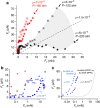Supramolecular synergy in the boundary lubrication of synovial joints
- PMID: 25754223
- PMCID: PMC4366511
- DOI: 10.1038/ncomms7497
Supramolecular synergy in the boundary lubrication of synovial joints
Abstract
Hyaluronan, lubricin and phospholipids, molecules ubiquitous in synovial joints, such as hips and knees, have separately been invoked as the lubricants responsible for the remarkable lubrication of articular cartilage; but alone, these molecules cannot explain the extremely low friction at the high pressures of such joints. We find that surface-anchored hyaluronan molecules complex synergistically with phosphatidylcholine lipids present in joints to form a boundary lubricating layer, which, with coefficient of friction μ≈0.001 at pressures to over 100 atm, has a frictional behaviour resembling that of articular cartilage in the major joints. Our findings point to a scenario where each of the molecules has a different role but must act together with the others: hyaluronan, anchored at the outer surface of articular cartilage by lubricin molecules, complexes with joint phosphatidylcholines to provide the extreme lubrication of synovial joints via the hydration-lubrication mechanism.
Figures




Comment in
-
Basic research: synovial surfaces use synergy to slide.Nat Rev Rheumatol. 2015 May;11(5):259. doi: 10.1038/nrrheum.2015.42. Epub 2015 Mar 31. Nat Rev Rheumatol. 2015. PMID: 25825282 No abstract available.
Similar articles
-
Lubrication of Articular Cartilage.Annu Rev Biomed Eng. 2016 Jul 11;18:235-58. doi: 10.1146/annurev-bioeng-081514-123305. Annu Rev Biomed Eng. 2016. PMID: 27420572 Review.
-
Articular cartilage proteoglycans as boundary lubricants: structure and frictional interaction of surface-attached hyaluronan and hyaluronan--aggrecan complexes.Biomacromolecules. 2011 Oct 10;12(10):3432-43. doi: 10.1021/bm2004912. Epub 2011 Sep 1. Biomacromolecules. 2011. PMID: 21823600
-
The Role of Hyaluronic Acid in Cartilage Boundary Lubrication.Cells. 2020 Jul 2;9(7):1606. doi: 10.3390/cells9071606. Cells. 2020. PMID: 32630823 Free PMC article.
-
The boundary lubrication of chemically grafted and cross-linked hyaluronic acid in phosphate buffered saline and lipid solutions measured by the surface forces apparatus.Langmuir. 2012 Jan 31;28(4):2244-50. doi: 10.1021/la203851w. Epub 2011 Dec 22. Langmuir. 2012. PMID: 22148857
-
Hydrostatic and boundary lubrication of joints--nature of boundary lubricant.Ortop Traumatol Rehabil. 2012 Jan-Feb;14(1):13-21. doi: 10.5604/15093492.976894. Ortop Traumatol Rehabil. 2012. PMID: 22402631 Review. English, Polish.
Cited by
-
Self-assembly of sustainable plant protein protofilaments into a hydrogel for ultra-low friction across length scales.Commun Mater. 2024;5(1):158. doi: 10.1038/s43246-024-00590-5. Epub 2024 Sep 3. Commun Mater. 2024. PMID: 39238825 Free PMC article.
-
Effects of Hyaluronan Molecular Weight on the Lubrication of Cartilage-Emulating Boundary Layers.Biomacromolecules. 2020 Oct 12;21(10):4345-4354. doi: 10.1021/acs.biomac.0c01151. Epub 2020 Sep 24. Biomacromolecules. 2020. PMID: 32931261 Free PMC article.
-
Triborheological Study under Physiological Conditions of PVA Hydrogel/HA Lubricant as Synthetic System for Soft Tissue Replacement.Polymers (Basel). 2021 Feb 28;13(5):746. doi: 10.3390/polym13050746. Polymers (Basel). 2021. PMID: 33670837 Free PMC article.
-
Recent Progress in Hydrogel-Based Synthetic Cartilage: Focus on Lubrication and Load-Bearing Capacities.Gels. 2023 Feb 8;9(2):144. doi: 10.3390/gels9020144. Gels. 2023. PMID: 36826314 Free PMC article. Review.
-
Molecular Dynamic Analysis of Hyaluronic Acid and Phospholipid Interaction in Tribological Surgical Adjuvant Design for Osteoarthritis.Molecules. 2017 Sep 4;22(9):1436. doi: 10.3390/molecules22091436. Molecules. 2017. PMID: 28869569 Free PMC article.
References
-
- Hodge W. A. et al.. Contact pressures from an instrumented hip endoprosthesis. J. Bone Joint Surg. Am. 71A, 1378–1386 (1989) . - PubMed
-
- Radin E. L. & Paul I. L. Response of joints to impact loading. I. In vitro wear. Arthritis Rheum. 14, 356–362 (1971) . - PubMed
-
- Forster H. & Fisher J. The influence of loading time and lubricant on the friction of articular cartilage. Proc. Inst. Mech. Eng. H. 210, 109–119 (1996) . - PubMed
-
- Afoke N. Y. P., Byers P. D. & Hutton W. C. Contact pressures in the human hip joint. J. Bone Joint Surg. Am. 69B, 536–541 (1987) . - PubMed
-
- Dowson D. in Symposium on Lubrication and wear in living and artificial joints 45–54Inst. Mech, Eng. (1967) .
Publication types
MeSH terms
Substances
Grants and funding
LinkOut - more resources
Full Text Sources
Other Literature Sources
Research Materials
Miscellaneous

